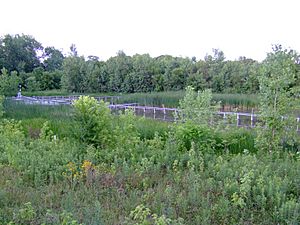Olentangy River Wetland Research Park facts for kids
Quick facts for kids
Designations
|
|
| Official name: Wilma H. Schiermeier Olentangy River Wetland Research Park | |
| Designated: | 18 April 2008 |
|---|---|
| Reference #: | 1779 |
The Wilma H. Schiermeier Olentangy River Wetland Research Park is a special outdoor science lab located right next to Ohio State University in Columbus, Ohio. It's a part of the university's School of Environment and Natural Resources.
Started in 1992, this park has grown into many different types of natural areas and setups. University teachers and students use these areas for important science projects. You can also visit the park on your own during the day, or you can ask for a guided tour to learn even more!
Contents
What is the Wetland Park?
This park covers about 20 hectares (50 acres) of land. It sits along the Olentangy River. Professor William J. Mitsch led the creation and development of this research park. He even won a big award, the Stockholm Water Prize, partly because of his work here!
Building the First Wetlands
The first part of the park was finished in 1994. Two large, kidney-shaped marshes were built. Each marsh is about 1 hectare (2.5 acres) in size. Water is always pumped into these marshes from the river, keeping the water level steady all year.
- Experimental Wetland 1 (on the west side) was planted with wetland plants that naturally grow in the area.
- Experimental Wetland 2 (on the east side) was left unplanted.
Scientists watch these two wetlands every year to see how they grow and change differently. This helps them understand how wetlands develop. Boardwalks were added in 1995 and 1996. These allow people to walk through the wetland without disturbing the ground or the experiments. Usually, these boardwalks are only open during guided tours to protect the ongoing research.
Adding More Habitats
In 1999, a new area called a Billabong was built. It's about 3 hectares (7.5 acres) and looks like an oxbow lake. Water flows into this area from the Olentangy River only when the river is high. So, sometimes, especially in summer, you might see this area almost completely dry. This is totally normal!
At the same time, a Mesocosm Compound was built. This area has smaller setups for scientists to do research on a smaller scale.
Restoring the Forest
A large bottomland hardwood forest, about 5 hectares (12 acres), was restored in 1999-2000. This was done by making four openings in an artificial wall (levee). This allowed the river to flood the forest again, just like it would naturally. Studies show that the forest is now healthier and grows better.
Sometimes, a plant called Eurasian honeysuckle is removed from this forest. This plant is an invasive species, meaning it's not native and can take over. Removing it helps other native plants grow better underneath the trees.
New Buildings and Small Wetlands
The third phase of the park finished in 2003 with the construction of the Heffner Wetland Research and Education Building. Along with the building, three smaller wetlands were created:
- A stormwater wetland collects rain that falls on the building's roof. It helps filter the water.
- A pond was dug deep enough to reach the underground water. This provides a constant supply of water to a nearby swale (a low, wet area).
- To the west of the building, there's a small decorative wetland and a new red maple swamp growing.
A Wetland of International Importance
In June 2008, the Olentangy River Wetland Research Park received a very special honor. It was named a Ramsar Wetland of International Importance. This means it's recognized globally for its importance! It was one of the first human-made wetlands in the world to get this designation.
This park was chosen because:
- It has many different kinds of plants and animals.
- A lot of important wetland research happens here.
- Many people visit the park (about 150 tours per year!). These visits help educate thousands of people about how important wetlands are.
Images for kids



